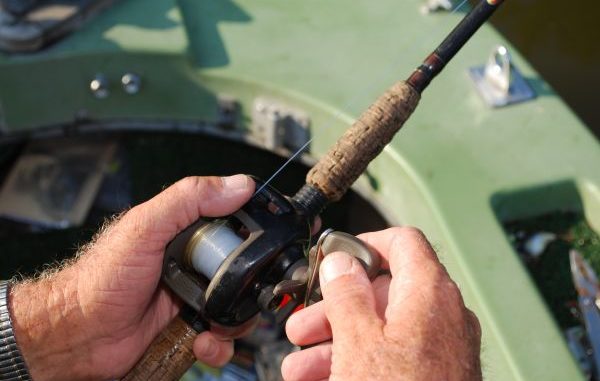
Modern bass fishermen are known for their endless array of fancy and expensive equipment. Fishing with Jim Looney is like a throwback to a simpler time, a time when it seemed like any angler could be reasonably confident of catching bass.
His boat is a 1973 Starcraft, of the first generation of bass boats often called “banana boats” because of their long, slim shape.
“I bought the boat brand new,” Looney proclaimed. “Boat, motor and trailer were about $2,500.”
The fiberglass hull is powered by a modest 60 horsepower motor.
“I’m not in that big a hurry to get to my fishing hole,” he explained. “I’m not going to kill myself getting there.”
All day, big metal-flaked monsters powered by huge gas guzzlers pass him while he fishes. Few of them stop to fish.
Looney’s boat is rigged with bow stick controls and a foot-controlled trolling motor. He both operates the boat and fishes while staying seated comfortably; none of this standing all the time and constantly having to work the trolling motor by hand.
His rods and reels are not the latest in high-tech fashion, either.
For bream fishing, he uses a Zebco 33 spincast reel rigged with 12-pound-test line. He gets hung up a lot where he fishes bream and needs the heavier-than-one-might-expect line. Plus when he fishes with his favorite bream jigs, the Bass Pro Shops Triple Ripple Grub, the heavier line causes the jig to sink slower.
Bass fishing equipment is just as simple. His reels are all classic baitcasters, and his admitted favorite is Ambassador 5500 C.
He uses a variety of rods, all sharing one characteristic: They are 5 ½ feet long.
“I don’t make long casts,” he said. “With less line out, I don’t have to set the hook so hard.”
He chuckled when I admired the chewed up cork grips on the well-used rod in his hands.
“By the time I change rods, they ain’t worth much,” Looney said. “But I change the eyes on them regularly.”
As for the latest and hottest bass lures, he hasn’t been taken in.
“They’re more for the fisherman than the fish — but you know fishermen: If they think that they can catch one more fish, they will buy that $5 bait,” he quipped.
He loves plastic worms, usually the Culprit models, but occasionally a Shim-E-Stick — both invariably in red shad color.
“I’ve been fishing worms since 1964, when they first came out,” he said matter-of-factly.
He has little use for the other great classic bass lure type, the spinner bait.
“I will use them, but they will wear you out,” he said. “Cast — retrieve. Cast — retrieve. There is no finesse to them.
“The theory is that you can cover more water. I’ve got a buddy who just loves spinner baits — til you get too far ahead of him. I’ve always put my biggest fish in the boat with plastic worms.”
He described his entire fishing equipment philosophy in three sentences.
“I’m not one to do a lot of experimenting.,” he said. “If it works, don’t try to fix it. The stuff I fish with works.”